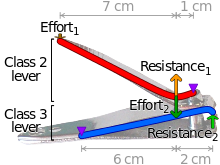Nail Clipper Lever System
At first glance, it appears to be a simple lever, but upon further inspection it can be seen to be a system of two levers in series. The first lever is a CLASS 2 lever with the fulcrum at the post near the clipping end, with the load situated in between the fulcrum and the applied force. It has an applied force lever arm that is approximately 8 times the length of the load lever arm giving a MECHANICAL ADVANTAGE (MA) of about 8, allowing a load force that is approximately 8 times the value of the applied force. This gives the user a FORCE ADVANTAGE.
The load force of the first lever becomes the applied force of the second lever . The applied force is situated in between the fulcrum and the load (the clipping parts), making this a CLASS 3 lever.
The applied force lever arm is approximately four fifths the length of the load lever arm, making the MA of this lever less than one and giving the user a small DISTANCE ADVANTAGE.
Since the two levers are in series, the total MA of the system is the product of the two individual MA’s, resulting in an approximate system MA of 8*(4/5)=6.4.
The overall advantage is a FORCE ADVANTAGE, giving a force on the load that is greater than the force applied, particularly useful when trimming the nail of the big toe.
Thus we can see that the nail cutter is a compound lever.
Thus we can see that the nail cutter is a compound lever.
The compound lever is a simple machine operating on the premise that the resistance from one lever in a system of levers will act as power for the next, and thus the applied force will be amplified from one lever to the next (as long as the mechanical advantage for each lever is greater than one).
How Does The Nailcutter Work
 Reviewed by CREATIVE SCIENCES
on
September 10, 2018
Rating:
Reviewed by CREATIVE SCIENCES
on
September 10, 2018
Rating:
 Reviewed by CREATIVE SCIENCES
on
September 10, 2018
Rating:
Reviewed by CREATIVE SCIENCES
on
September 10, 2018
Rating:







